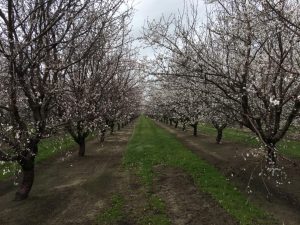 Bloom has arrived in California’s Central Valley and growers are preparing to apply their bloom spray programs. Depending on the location of your farm, your nutrient needs may differ depending on soil and irrigation water quality.
Bloom has arrived in California’s Central Valley and growers are preparing to apply their bloom spray programs. Depending on the location of your farm, your nutrient needs may differ depending on soil and irrigation water quality.
Kirk Anderson, our Northern CA Territory Sales manager has some advice during bloom about which nutrients are best to use, and how to achieve a beneficial blend of nutrients that will give the quality and yields growers want.
Boron improves pollen viability and therefore contributes to increased fruit set. Boron also contributes to the differentiation of meristemic cells, assists in calcium uptake, and the movement of starch to the roots. The best time for boron applications is during “pink bud” in orchards and then as needed after pollination or petal fall.
Calcium is essential during early cell division and growth, resulting in a distinct effect on vegetation and fruit set. Adequate calcium is important for forming cell walls, rigid structures, enhancing pollen germination and growth. Calcium is not very mobile in plant tissues, which makes foliar applications especially important during periods of rapid cell division and growth. Adequate calcium during bloom improves quality of fruit, especially in stone and pome fruit, where flavor, shipping, and storage qualities are especially important to growers.
Zinc is another essential nutrient that is not very mobile and works best as a foliar spray. Zinc is needed for the formation of chlorophyll, hormone growth, and plant protein synthesis. It is essential for proper cell elongation, internodal growth, lengthening of internodes, and in vineyards, for the full expansion in bunches. Zinc is known to be deficient in many western soils and zinc applications are beneficial in dormant, delayed dormant, and bloom spray programs.
Iron and Manganese uptake is affected by soil pH, free lime, and irrigation water high in bicarbonates. Iron is required for chlorophyll formation and serves as an activator for respiration, photosynthesis, and symbiotic nitrogen fixation. Manganese serves as an activator for enzymes in plant growth processes and formation of chlorophyll. Iron and manganese deficiency symptoms are often seen in spring and early summer and need to be corrected by applying nutrients. These two nutrients affect the uptake and availability of each other, so using the correct forms in the right amounts is important to see the benefits.
Kirk bases his bloom spray programs on either Tech-Flo Bloom Blend or Tech-Flo All Season Blend. Each has a balanced blend of essential nutrients. All Season is slightly more concentrated and includes potassium and more sulfur than Bloom Blend. Tech-Flo Zeta Zinc or Tech-Flo Phi are often added as targeted nutrients to address each orchard’s individual needs. You can review our product composition chart here.
Bloom is a time when safe nutrients need to be applied in quantities that are able to make an agronomic difference. POLYSORBYGEN makes Tech-Flo products perfect for bloom applications. Read more about the Power of POLYSORBYGEN here.
For specific advice for your farm, contact your PCA, fertilizer dealer or one of our PCA’s.


